Intrinsic amino acid side-chain hydrophilicity/hydrophobicity coefficients determined by reversed-phase high-performance liquid chromatography of model peptides: comparison with other hydrophilicity/hydrophobicity scales
- PMID: 19795449
- PMCID: PMC2792893
- DOI: 10.1002/bip.21316
Intrinsic amino acid side-chain hydrophilicity/hydrophobicity coefficients determined by reversed-phase high-performance liquid chromatography of model peptides: comparison with other hydrophilicity/hydrophobicity scales
Abstract
An accurate determination of the intrinsic hydrophilicity/hydrophobicity of amino acid side-chains in peptides and proteins is fundamental in understanding many area of research, including protein folding and stability, peptide and protein function, protein-protein interactions and peptide/protein oligomerization, as well as the design of protocols for purification and characterization of peptides and proteins. Our definition of intrinsic hydrophilicity/hydrophobicity of side-chains is the maximum possible hydrophilicity/hydrophobicity of side-chains in the absence of any nearest-neighbor effects and/or any conformational effects of the polypeptide chain that prevent full expression of side-chain hydrophilicity/hydrophobicity. In this review, we have compared an experimentally derived intrinsic side-chain hydrophilicity/hydrophobicity scale generated from RP-HPLC retention behavior of de novo designed synthetic model peptides at pH 2 and pH 7 with other RP-HPLC-derived scales, as well as scales generated from classic experimental and calculation-based methods of octanol/water partitioning of Nalpha-acetyl-amino-acid amides or free energy of transfer of free amino acids. Generally poor correlation was found with previous RP-HPLC-derived scales, likely due to the random nature of the peptide mixtures in terms of varying peptide size, conformation and frequency of particular amino acids. In addition, generally poor correlation with the classical approaches served to underline the importance of the presence of a polypeptide backbone when generating intrinsic values. We have shown that the intrinsic scale determined here is in full agreement with the structural characteristics of amino acid side-chains.
Copyright 2009 Wiley Periodicals, Inc.
Figures


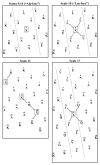

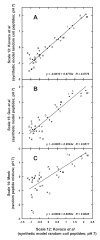
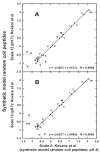

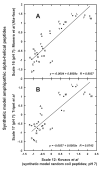
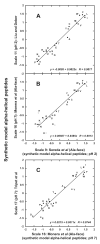

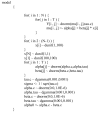

Similar articles
-
Determination of intrinsic hydrophilicity/hydrophobicity of amino acid side chains in peptides in the absence of nearest-neighbor or conformational effects.Biopolymers. 2006;84(3):283-97. doi: 10.1002/bip.20417. Biopolymers. 2006. PMID: 16315143 Free PMC article.
-
Defining intrinsic hydrophobicity of amino acids' side chains in random coil conformation. Reversed-phase liquid chromatography of designed synthetic peptides vs. random peptide data sets.J Chromatogr A. 2011 Sep 16;1218(37):6348-55. doi: 10.1016/j.chroma.2011.06.092. Epub 2011 Jul 3. J Chromatogr A. 2011. PMID: 21798546
-
Quantitation of the nearest-neighbour effects of amino acid side-chains that restrict conformational freedom of the polypeptide chain using reversed-phase liquid chromatography of synthetic model peptides with L- and D-amino acid substitutions.J Chromatogr A. 2006 Aug 11;1123(2):212-24. doi: 10.1016/j.chroma.2006.04.092. Epub 2006 May 19. J Chromatogr A. 2006. PMID: 16712857 Free PMC article.
-
Prediction of peptides retention behavior in reversed-phase liquid chromatography based on their hydrophobicity.J Sep Sci. 2023 Jan;46(2):e2200743. doi: 10.1002/jssc.202200743. Epub 2022 Nov 14. J Sep Sci. 2023. PMID: 36349538 Free PMC article. Review.
-
Retention Time Prediction and Protein Identification.Methods Mol Biol. 2020;2051:115-132. doi: 10.1007/978-1-4939-9744-2_4. Methods Mol Biol. 2020. PMID: 31552626 Review.
Cited by
-
Synergistic Antibacterial Activity of Designed Trp-Containing Antibacterial Peptides in Combination With Antibiotics Against Multidrug-Resistant Staphylococcus epidermidis.Front Microbiol. 2019 Nov 25;10:2719. doi: 10.3389/fmicb.2019.02719. eCollection 2019. Front Microbiol. 2019. PMID: 31824473 Free PMC article.
-
Autoimmune Responses to Soluble Aggregates of Amyloidogenic Proteins Involved in Neurodegenerative Diseases: Overlapping Aggregation Prone and Autoimmunogenic regions.Sci Rep. 2016 Feb 29;6:22258. doi: 10.1038/srep22258. Sci Rep. 2016. PMID: 26924748 Free PMC article.
-
Anti-tuberculosis activity of α-helical antimicrobial peptides: de novo designed L- and D-enantiomers versus L- and D-LL-37.Protein Pept Lett. 2011 Mar;18(3):241-52. doi: 10.2174/092986611794578288. Protein Pept Lett. 2011. PMID: 20858205 Free PMC article.
-
Enthalpic and Entropic Contributions to Hydrophobicity.J Chem Theory Comput. 2016 Sep 13;12(9):4600-10. doi: 10.1021/acs.jctc.6b00422. Epub 2016 Aug 16. J Chem Theory Comput. 2016. PMID: 27442443 Free PMC article.
-
Systematic Moiety Variations of Ultrashort Peptides Produce Profound Effects on Self-Assembly, Nanostructure Formation, Hydrogelation, and Phase Transition.Sci Rep. 2017 Oct 10;7(1):12897. doi: 10.1038/s41598-017-12694-9. Sci Rep. 2017. PMID: 29018249 Free PMC article.
References
Publication types
MeSH terms
Substances
Grants and funding
LinkOut - more resources
Full Text Sources
Other Literature Sources

